Nutrition Essentials (37)
Foundations
-

Nutrition, part 14: Nutrition for Older Adults
Cathy Parkes RN, BSN, PHN, CWCNNutrition for older adults. Changes that occur as we get older that affect nutrition. Nutritional and lifestyle guidance for older adults.
Nutrition, part 14: Nutrition for Older Adults
Cathy Parkes RN, BSN, PHN, CWCNNutrition for older adults. Changes that occur as we get older that affect nutrition. Nutritional and lifestyle guidance for older adults.
-

Nutrition, part 13: Childhood Nutrition
Cathy Parkes RN, BSN, PHN, CWCNNutritional recommendations for toddlers, school age children, and adolescents.
Nutrition, part 13: Childhood Nutrition
Cathy Parkes RN, BSN, PHN, CWCNNutritional recommendations for toddlers, school age children, and adolescents.
-

Nutrition, part 12: Infant Nutrition
Cathy Parkes RN, BSN, PHN, CWCNInfant nutrition, including expected weight gain, introduction of solid food, choking hazards, breastmilk storage, and formula preparation and storage.
Nutrition, part 12: Infant Nutrition
Cathy Parkes RN, BSN, PHN, CWCNInfant nutrition, including expected weight gain, introduction of solid food, choking hazards, breastmilk storage, and formula preparation and storage.
-

Nutrition, part 11: Nutrition During Pregnancy
Cathy Parkes RN, BSN, PHN, CWCNNutrition during pregnancy. Key nutrients needed during pregnancy, including: folic acid, protein, iron, calcium, vitamin D, and fluids. Weight gain and increased calorie intake during pregnancy. Nutrition for key pregnancy...
Nutrition, part 11: Nutrition During Pregnancy
Cathy Parkes RN, BSN, PHN, CWCNNutrition during pregnancy. Key nutrients needed during pregnancy, including: folic acid, protein, iron, calcium, vitamin D, and fluids. Weight gain and increased calorie intake during pregnancy. Nutrition for key pregnancy...
-

Nutrition, part 10: Vegetarian Diets and Religious & Cultural Dietary Consideration
Cathy Parkes RN, BSN, PHN, CWCNThe different types of vegetarian diets (e.g., vegan, lacto vegetarian, lacto-ovo vegetarian, pescatarian). Religious dietary considerations for Buddhism, Catholicism, Hinduism, Islam, Jehovah's Witnesses, Judaism, and Mormonism. Cultural dietary considerations for...
Nutrition, part 10: Vegetarian Diets and Religious & Cultural Dietary Consideration
Cathy Parkes RN, BSN, PHN, CWCNThe different types of vegetarian diets (e.g., vegan, lacto vegetarian, lacto-ovo vegetarian, pescatarian). Religious dietary considerations for Buddhism, Catholicism, Hinduism, Islam, Jehovah's Witnesses, Judaism, and Mormonism. Cultural dietary considerations for...
-

Nutrition, part 9: Nutrition & Activity Guidelines for Adults & Weight Loss
Cathy Parkes RN, BSN, PHN, CWCNNutritional guidance for adults, including foods that should be included in a healthy diet, and foods and beverages that should be avoided or limited. Activity guidelines for adults, based on...
Nutrition, part 9: Nutrition & Activity Guidelines for Adults & Weight Loss
Cathy Parkes RN, BSN, PHN, CWCNNutritional guidance for adults, including foods that should be included in a healthy diet, and foods and beverages that should be avoided or limited. Activity guidelines for adults, based on...
-

Nutrition, part 8: Daily Caloric Requirements and Body Mass Index
Cathy Parkes RN, BSN, PHN, CWCNThe calculation of an individual's daily caloric requirements, which is based on their basal metabolic rate (BMR), physical activity, and the thermic effect of feeding (TEF). Factors that increase BMR...
Nutrition, part 8: Daily Caloric Requirements and Body Mass Index
Cathy Parkes RN, BSN, PHN, CWCNThe calculation of an individual's daily caloric requirements, which is based on their basal metabolic rate (BMR), physical activity, and the thermic effect of feeding (TEF). Factors that increase BMR...
-

Nutrition, part 7: Water
Cathy Parkes RN, BSN, PHN, CWCNWater, including the role of water in the body, the recommended daily intake of water, types of water loss, and signs/symptoms of dehydration.
Nutrition, part 7: Water
Cathy Parkes RN, BSN, PHN, CWCNWater, including the role of water in the body, the recommended daily intake of water, types of water loss, and signs/symptoms of dehydration.
-
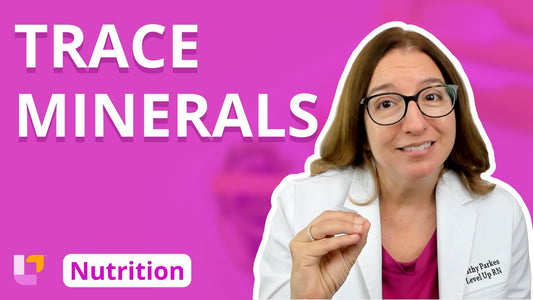
Nutrition, part 6: Trace Minerals - Iron, Fluoride, Iodine, Zinc
Cathy Parkes RN, BSN, PHN, CWCNKey trace minerals overview: iron, fluoride, iodine, zinc. Functions of iron, dietary sources of iron, signs/symptoms of deficiency, treatment of iron deficiency, and key patient teaching for iron supplements. Plus,...
Nutrition, part 6: Trace Minerals - Iron, Fluoride, Iodine, Zinc
Cathy Parkes RN, BSN, PHN, CWCNKey trace minerals overview: iron, fluoride, iodine, zinc. Functions of iron, dietary sources of iron, signs/symptoms of deficiency, treatment of iron deficiency, and key patient teaching for iron supplements. Plus,...
-

Nutrition, part 5: Electrolytes - Calcium, Magnesium, Phosphorus, Potassium, Sodium
Cathy Parkes RN, BSN, PHN, CWCNCalcium, Magnesium, Phosphorus, Potassium, Sodium: Function, normal range, mnemonic hints, dietary sources, and signs/symptoms of excess or deficiency.
Nutrition, part 5: Electrolytes - Calcium, Magnesium, Phosphorus, Potassium, Sodium
Cathy Parkes RN, BSN, PHN, CWCNCalcium, Magnesium, Phosphorus, Potassium, Sodium: Function, normal range, mnemonic hints, dietary sources, and signs/symptoms of excess or deficiency.
-

Nutrition, part 4: Fat Soluble Vitamins - Vitamins A, D, E, K
Cathy Parkes RN, BSN, PHN, CWCNWhat does the body use vitamins A, D, E, and K for? Which foods are good sources of these vitamins? We'll cover all of this plus the signs of deficiency...
2 commentsNutrition, part 4: Fat Soluble Vitamins - Vitamins A, D, E, K
Cathy Parkes RN, BSN, PHN, CWCNWhat does the body use vitamins A, D, E, and K for? Which foods are good sources of these vitamins? We'll cover all of this plus the signs of deficiency...
2 comments -

Nutrition, part 3: Water Soluble Vitamins - B-complex vitamins, vitamin C
Cathy Parkes RN, BSN, PHN, CWCNThiamin, Riboflavin, Niacin, Pyridoxine, Folic Acid, Cobalamin, Vitamin C: Functions, sources, deficiency risks & conditions. Plus, scurvy!
1 commentNutrition, part 3: Water Soluble Vitamins - B-complex vitamins, vitamin C
Cathy Parkes RN, BSN, PHN, CWCNThiamin, Riboflavin, Niacin, Pyridoxine, Folic Acid, Cobalamin, Vitamin C: Functions, sources, deficiency risks & conditions. Plus, scurvy!
1 comment -

Nutrition, part 2: Macronutrients - Carbohydrates, Lipids, Protein
Cathy Parkes RN, BSN, PHN, CWCNThe lowdown on the three macronutrients, including function and food sources for each. Carbohydrates: simple vs. complex, glycogen, and fiber. Fat: saturated vs. unsaturated vs. trans, and cholesterol. Protein: amino...
Nutrition, part 2: Macronutrients - Carbohydrates, Lipids, Protein
Cathy Parkes RN, BSN, PHN, CWCNThe lowdown on the three macronutrients, including function and food sources for each. Carbohydrates: simple vs. complex, glycogen, and fiber. Fat: saturated vs. unsaturated vs. trans, and cholesterol. Protein: amino...
-

Nutrition, part 1: Introduction, Overview of Nutrients
Cathy Parkes RN, BSN, PHN, CWCNWhat's the difference between a macronutrient and a micronutrient? A water soluble vitamin vs. a fat soluble vitamin? A major mineral vs. a trace mineral? In this introduction to our...
Nutrition, part 1: Introduction, Overview of Nutrients
Cathy Parkes RN, BSN, PHN, CWCNWhat's the difference between a macronutrient and a micronutrient? A water soluble vitamin vs. a fat soluble vitamin? A major mineral vs. a trace mineral? In this introduction to our...
Nutrition for Nursing Practice
-
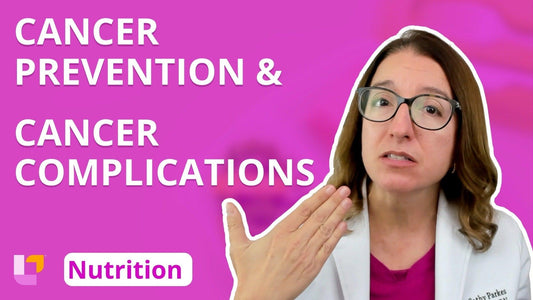
Nutrition, part 37: Nutrition for Cancer Prevention and Cancer Complications
Cathy Parkes RN, BSN, PHN, CWCNNutritional and lifestyle recommendations for cancer prevention. Key complications of cancer and cancer treatment, including decreased appetite and weight loss, xerostomia, taste alterations, and stomatitis.
Nutrition, part 37: Nutrition for Cancer Prevention and Cancer Complications
Cathy Parkes RN, BSN, PHN, CWCNNutritional and lifestyle recommendations for cancer prevention. Key complications of cancer and cancer treatment, including decreased appetite and weight loss, xerostomia, taste alterations, and stomatitis.
-
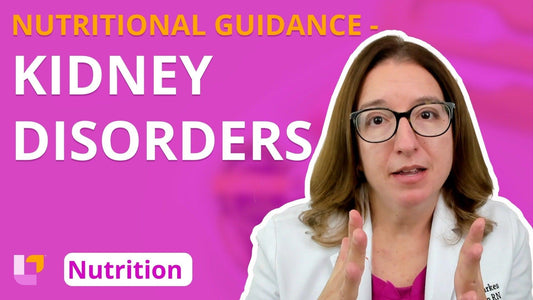
Nutrition, part 36: Nutritional Guidance for Kidney Disorders
Cathy Parkes RN, BSN, PHN, CWCNNutritional guidance for the following renal disorders: acute kidney injury (AKI), chronic kidney disease (CKD), nephrotic syndrome, glomerulonephritis, and urolithiasis (including nephrolithiasis).
Nutrition, part 36: Nutritional Guidance for Kidney Disorders
Cathy Parkes RN, BSN, PHN, CWCNNutritional guidance for the following renal disorders: acute kidney injury (AKI), chronic kidney disease (CKD), nephrotic syndrome, glomerulonephritis, and urolithiasis (including nephrolithiasis).
-
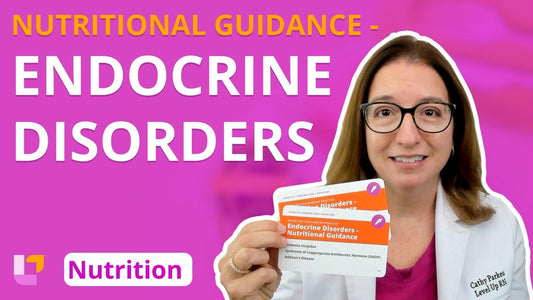
Nutrition, part 35: Nutritional Guidance for Endocrine Disorders
Cathy Parkes RN, BSN, PHN, CWCNNutritional guidance for the following endocrine disorders: diabetes insipidus (DI), syndrome of inappropriate antidiuretic hormone (SIADH), Addison's disease, Cushing's Syndrome, hypothyroidism, and hyperthyroidism.
Nutrition, part 35: Nutritional Guidance for Endocrine Disorders
Cathy Parkes RN, BSN, PHN, CWCNNutritional guidance for the following endocrine disorders: diabetes insipidus (DI), syndrome of inappropriate antidiuretic hormone (SIADH), Addison's disease, Cushing's Syndrome, hypothyroidism, and hyperthyroidism.
-
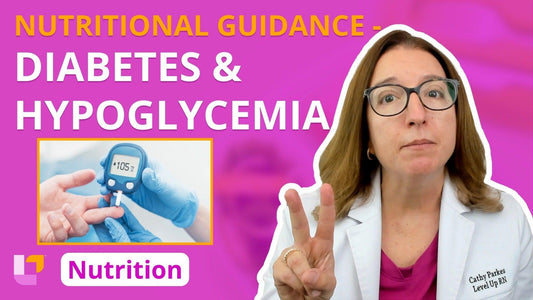
Nutrition, part 34: Nutritional Guidance for Diabetes & Hypoglycemia
Cathy Parkes RN, BSN, PHN, CWCNDiabetes, including the signs/symptoms, nutritional guidance, and Somogyi phenomenon. Hypoglycemia, including the causes, signs/symptoms, and nutritional guidance for a conscious patient with hypoglycemia.
Nutrition, part 34: Nutritional Guidance for Diabetes & Hypoglycemia
Cathy Parkes RN, BSN, PHN, CWCNDiabetes, including the signs/symptoms, nutritional guidance, and Somogyi phenomenon. Hypoglycemia, including the causes, signs/symptoms, and nutritional guidance for a conscious patient with hypoglycemia.
-
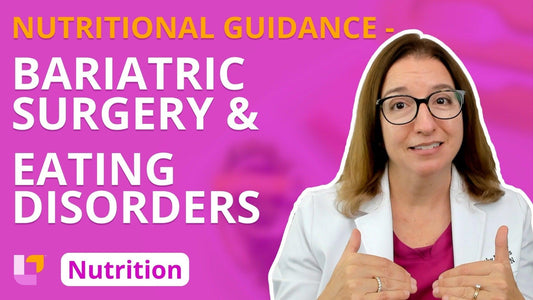
Nutrition, part 33: Nutritional Guidance for Bariatric Surgery & Eating Disorders
Cathy Parkes RN, BSN, PHN, CWCNNutritional recommendations for patients after bariatric surgery. Nutritional considerations when caring for a patients with eating disorders (anorexia nervosa and bulimia nervosa).
Nutrition, part 33: Nutritional Guidance for Bariatric Surgery & Eating Disorders
Cathy Parkes RN, BSN, PHN, CWCNNutritional recommendations for patients after bariatric surgery. Nutritional considerations when caring for a patients with eating disorders (anorexia nervosa and bulimia nervosa).
-
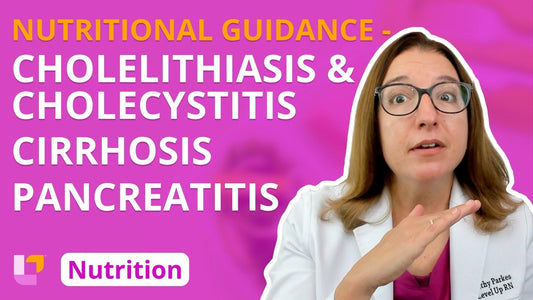
Nutrition, part 32: Nutritional Guidance for Cholelithiasis & Cholecystitis, Cirrhosis, Pancreatitis
Cathy Parkes RN, BSN, PHN, CWCNNutritional guidance for the following gastrointestinal disorders: cholelithiasis and cholecystitis, cirrhosis, and pancreatitis.
Nutrition, part 32: Nutritional Guidance for Cholelithiasis & Cholecystitis, Cirrhosis, Pancreatitis
Cathy Parkes RN, BSN, PHN, CWCNNutritional guidance for the following gastrointestinal disorders: cholelithiasis and cholecystitis, cirrhosis, and pancreatitis.
-
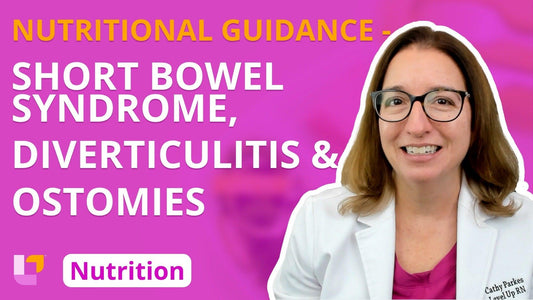
Nutrition, part 31: Nutritional Guidance for Short Bowel Syndrome, Diverticulitis, & Ostomies
Cathy Parkes RN, BSN, PHN, CWCNNutritional guidance for several gastrointestinal conditions, including: short bowel syndrome, diverticulitis, and ostomies.
Nutrition, part 31: Nutritional Guidance for Short Bowel Syndrome, Diverticulitis, & Ostomies
Cathy Parkes RN, BSN, PHN, CWCNNutritional guidance for several gastrointestinal conditions, including: short bowel syndrome, diverticulitis, and ostomies.
-
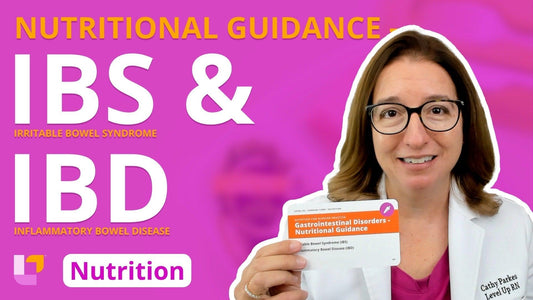
Nutrition, part 30: Nutritional Guidance for IBS and IBD
Cathy Parkes RN, BSN, PHN, CWCNNutritional guidance for irritable bowel syndrome (IBS) and inflammatory bowel disease (IBD).
Nutrition, part 30: Nutritional Guidance for IBS and IBD
Cathy Parkes RN, BSN, PHN, CWCNNutritional guidance for irritable bowel syndrome (IBS) and inflammatory bowel disease (IBD).
-

Nutrition, part 29: Celiac Disease
Cathy Parkes RN, BSN, PHN, CWCNThe pathophysiology of celiac disease, signs and symptoms of celiac disease, and patient teaching regarding celiac disease.
Nutrition, part 29: Celiac Disease
Cathy Parkes RN, BSN, PHN, CWCNThe pathophysiology of celiac disease, signs and symptoms of celiac disease, and patient teaching regarding celiac disease.
-
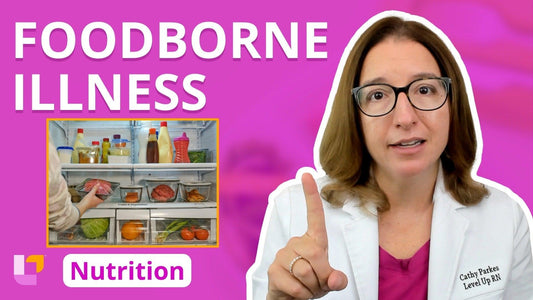
Nutrition, part 28: Foodborne Illness
Cathy Parkes RN, BSN, PHN, CWCNFoodborne illness, including common pathogens that cause foodborne illness, specific foods that are more likely to cause foodborne illness, signs/symptoms of foodborne illness, treatment of foodborne illness, and prevention of...
Nutrition, part 28: Foodborne Illness
Cathy Parkes RN, BSN, PHN, CWCNFoodborne illness, including common pathogens that cause foodborne illness, specific foods that are more likely to cause foodborne illness, signs/symptoms of foodborne illness, treatment of foodborne illness, and prevention of...
-

Nutrition, part 27: Nutritional Guidance for Nausea, Vomiting, Constipation, & Diarrhea
Cathy Parkes RN, BSN, PHN, CWCNNutritional guidance for nausea, vomiting, constipation, and diarrhea.
Nutrition, part 27: Nutritional Guidance for Nausea, Vomiting, Constipation, & Diarrhea
Cathy Parkes RN, BSN, PHN, CWCNNutritional guidance for nausea, vomiting, constipation, and diarrhea.
-
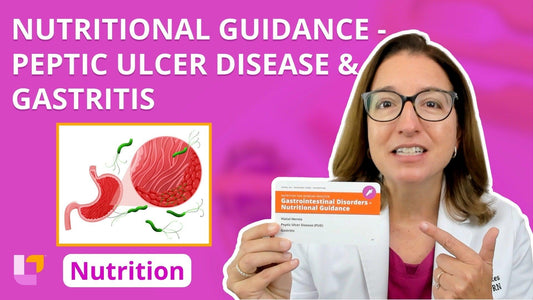
Nutrition, part 26: Nutritional Guidance for Peptic Ulcer Disease & Gastritis
Cathy Parkes RN, BSN, PHN, CWCNNutritional guidance for peptic ulcer disease (PUD) and gastritis.
Nutrition, part 26: Nutritional Guidance for Peptic Ulcer Disease & Gastritis
Cathy Parkes RN, BSN, PHN, CWCNNutritional guidance for peptic ulcer disease (PUD) and gastritis.
-
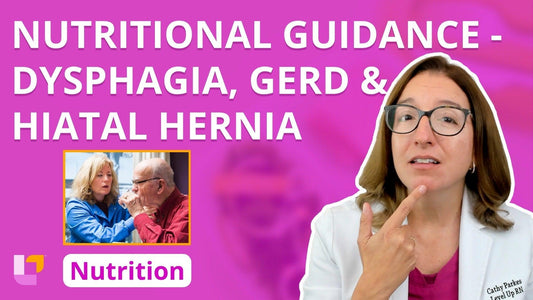
Nutrition, part 25: Nutritional Guidance - Dysphagia, GERD, & Hiatal Hernia
Cathy Parkes RN, BSN, PHN, CWCNNutritional and lifestyle guidance for the following gastrointestinal disorders: dysphagia, GERD, and a hiatal hernia.
Nutrition, part 25: Nutritional Guidance - Dysphagia, GERD, & Hiatal Hernia
Cathy Parkes RN, BSN, PHN, CWCNNutritional and lifestyle guidance for the following gastrointestinal disorders: dysphagia, GERD, and a hiatal hernia.
-
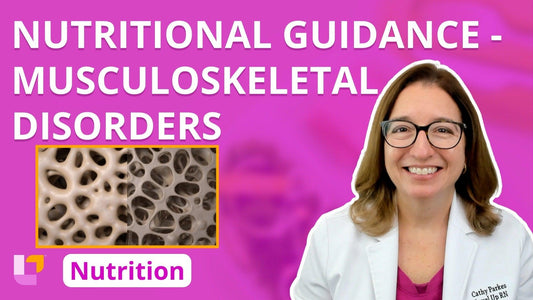
Nutrition, part 24: Nutritional Guidance for Musculoskeletal Disorders
Cathy Parkes RN, BSN, PHN, CWCNNutritional guidance for individuals with key musculoskeletal disorders, including osteoporosis, osteomalacia, and gout.
Nutrition, part 24: Nutritional Guidance for Musculoskeletal Disorders
Cathy Parkes RN, BSN, PHN, CWCNNutritional guidance for individuals with key musculoskeletal disorders, including osteoporosis, osteomalacia, and gout.
-
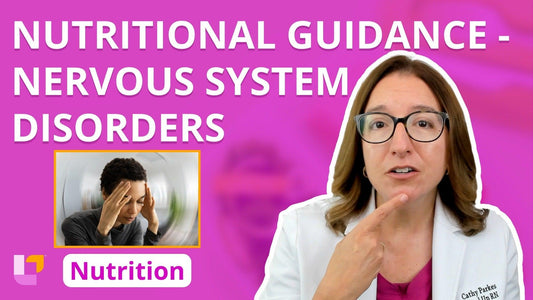
Nutrition, part 23: Nutrition for Nervous System Disorders
Cathy Parkes RN, BSN, PHN, CWCNNutritional guidance for nervous system disorders, including neurologic dysphagia, migraine headaches, and Meniere's disease.
Nutrition, part 23: Nutrition for Nervous System Disorders
Cathy Parkes RN, BSN, PHN, CWCNNutritional guidance for nervous system disorders, including neurologic dysphagia, migraine headaches, and Meniere's disease.
-
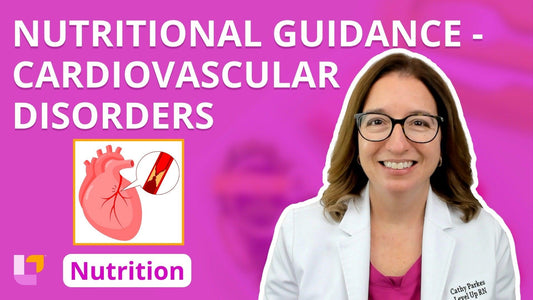
Nutrition, part 22: Nutritional Guidance for Cardiovascular Disorders
Cathy Parkes RN, BSN, PHN, CWCNNutritional guidance for cardiovascular disorders, including: coronary artery disease (CAD), hypertension, myocardial infarction (MI), and heart failure. Key characteristics of a heart healthy diet and heart healthy lifestyle changes.
Nutrition, part 22: Nutritional Guidance for Cardiovascular Disorders
Cathy Parkes RN, BSN, PHN, CWCNNutritional guidance for cardiovascular disorders, including: coronary artery disease (CAD), hypertension, myocardial infarction (MI), and heart failure. Key characteristics of a heart healthy diet and heart healthy lifestyle changes.
-
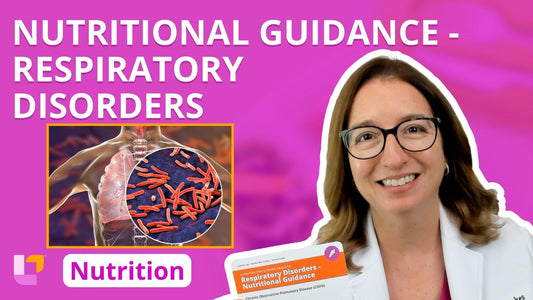
Nutrition, part 21: Nutritional Guidance for Respiratory Disorders
Cathy Parkes RN, BSN, PHN, CWCNNutritional guidance for individuals with respiratory disorders, including COPD, cystic fibrosis, and tuberculosis.
Nutrition, part 21: Nutritional Guidance for Respiratory Disorders
Cathy Parkes RN, BSN, PHN, CWCNNutritional guidance for individuals with respiratory disorders, including COPD, cystic fibrosis, and tuberculosis.
-

Nutrition, part 20: Metabolic Syndrome
Cathy Parkes RN, BSN, PHN, CWCNMetabolic syndrome. What metabolic syndrome is, risk factors for metabolic syndrome, signs/symptoms of metabolic syndrome, diagnostic criteria for metabolic syndrome, and treatment of metabolic syndrome (including nutritional and lifestyle changes).
Nutrition, part 20: Metabolic Syndrome
Cathy Parkes RN, BSN, PHN, CWCNMetabolic syndrome. What metabolic syndrome is, risk factors for metabolic syndrome, signs/symptoms of metabolic syndrome, diagnostic criteria for metabolic syndrome, and treatment of metabolic syndrome (including nutritional and lifestyle changes).
-

Nutrition, part 19: Protein Energy Malnutrition
Cathy Parkes RN, BSN, PHN, CWCNThe two main types of protein energy malnutrition: marasmus and kwashiorkor. The cause of each type of malnutrition, the signs/symptoms of each type of malnutrition, and the treatment of malnutrition.
Nutrition, part 19: Protein Energy Malnutrition
Cathy Parkes RN, BSN, PHN, CWCNThe two main types of protein energy malnutrition: marasmus and kwashiorkor. The cause of each type of malnutrition, the signs/symptoms of each type of malnutrition, and the treatment of malnutrition.
-

Nutrition, part 18: Food-Medication Interactions
Cathy Parkes RN, BSN, PHN, CWCNKey food-medication interactions. This includes the following foods and nutrients that may cause issues when taken with certain medications: tyramine, grapefruit juice, alcohol, dairy products, vitamin K, protein, and potassium.
Nutrition, part 18: Food-Medication Interactions
Cathy Parkes RN, BSN, PHN, CWCNKey food-medication interactions. This includes the following foods and nutrients that may cause issues when taken with certain medications: tyramine, grapefruit juice, alcohol, dairy products, vitamin K, protein, and potassium.
-

Nutrition, part 17: Parenteral Nutrition
Cathy Parkes RN, BSN, PHN, CWCNParenteral nutrition, with a focus on total parenteral nutrition (TPN). What parenteral nutrition is, indications for parenteral nutrition, and nursing care of TPN.
Nutrition, part 17: Parenteral Nutrition
Cathy Parkes RN, BSN, PHN, CWCNParenteral nutrition, with a focus on total parenteral nutrition (TPN). What parenteral nutrition is, indications for parenteral nutrition, and nursing care of TPN.
-
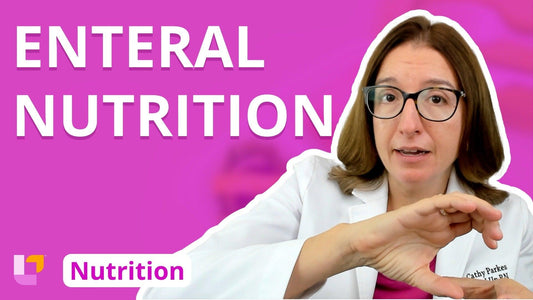
Nutrition, part 16: Enteral Nutrition
Cathy Parkes RN, BSN, PHN, CWCNEnteral nutrition. Indications for enteral feeding, feeding tubes used for short-term and long-term use, continuous vs. Intermittent feeding, and key points regarding nursing care of a patient with a feeding...
Nutrition, part 16: Enteral Nutrition
Cathy Parkes RN, BSN, PHN, CWCNEnteral nutrition. Indications for enteral feeding, feeding tubes used for short-term and long-term use, continuous vs. Intermittent feeding, and key points regarding nursing care of a patient with a feeding...
-
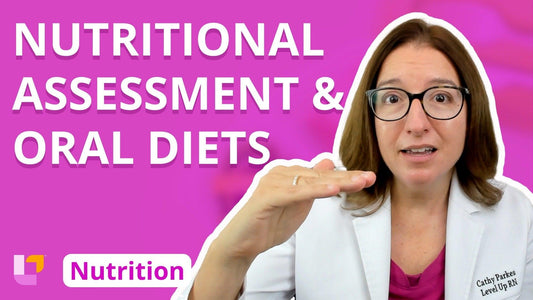
Nutrition, part 15: Nutritional Assessment & Oral Diets
Cathy Parkes RN, BSN, PHN, CWCNThe key components of a nursing nutritional assessment. The different types of oral diets, including: NPO, clear liquid, full liquid, pureed, soft, dysphagia, and a regular diet.
Nutrition, part 15: Nutritional Assessment & Oral Diets
Cathy Parkes RN, BSN, PHN, CWCNThe key components of a nursing nutritional assessment. The different types of oral diets, including: NPO, clear liquid, full liquid, pureed, soft, dysphagia, and a regular diet.





































